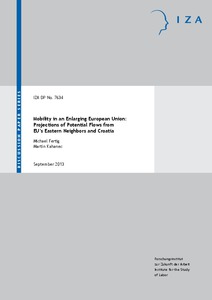Mobility in an enlarging European Union: projections of potential flows from EU's Eastern neighbors and Croatia

Fertig, Michael ; Kahanec, Martin
Institute of Labor Economics, Bonn
IZA - Bonn
2013
29 p.
EU enlargement ; freedom of movement ; migration
EU countries ; new EU countries
Discussion Paper
7634
Migration
English
Bibliogr.
"This study evaluates potential migration flows to the European Union from its eastern neighbors and Croatia. We perform out-of-sample forecasts using an adaption of the model of Hatton (1995) to time series cross-sectional data about post-enlargement migration flows following the EU's 2004 enlargement. We consider two baseline policy scenarios, with and without accession of sending countries to the EU. Our results show that migration flows are driven by migration costs and economic conditions, but the largest effects accrue to policy variables. In terms of the predicted flows: (i) we can expect modest migration flows in case of no liberalization of labor markets and only moderately increased migration flows under liberalization; (ii) after an initial increase following liberalization, migration flows will subside to long run steady state; (iii) Ukraine will send the most migrants; and (iv) the largest inflows in absolute terms are predicted for Germany, Italy and Austria, whereas Ireland, Denmark, Finland and again Austria are the main receiving countries relative to their population."
Digital
The ETUI is co-funded by the European Union. Views and opinions expressed are however those of the author(s) only and do not necessarily reflect those of the European Union or the ETUI.